 Image search results - "Nagasaki" Image search results - "Nagasaki" |
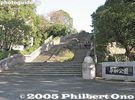
Entrance to the Peace Park
|
|

Peace Fountain with the Peace Statue in the distanceA fountain of water was made for the victims who were desperate for water.
|
|
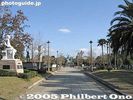
Path to Peace Statue
|
|
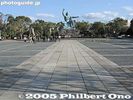
Peace StatueEvery Aug. 9, the anniversary of the atomic bombing, a memorial service is held here.
|
|
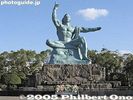
Peace StatueSculptor was Seibo Kitamura.
|
|

The Peace Statue was built in Aug. 1955, the 10th anniversary of the bombing. The Peace Statue was modeled after popular wrestler Rikidozan.
|
|

The folded right leg symbolizes quiet meditation.
|
|

The right hand points to the threat of nuclear weapons.The bronze statue is 10 meters tall.
|
|
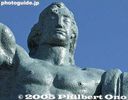
The closed eyes express a prayer for all war victims.
|
|
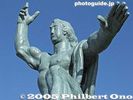
The outstretched left hand symbolizes tranquility and world peace.
|
|
|
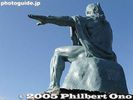
The left leg is poised for action to assist humanity.
|
|
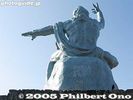
Rear view
|
|

Peace Statue description
|
|

Monument next to Peace Statue
|
|
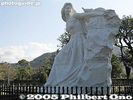
Peace memorial from ChinaThe park also has peace monuments from various countries.
|
|

Nagasaki atomic bomb peace park hypocenter
|
|

Peace memorial from Germany
|
|

Peace memorial from Czechoslovakia
|
|
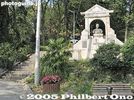
Statue of Ueno Hikoma
|
|

Hypocenter of atomic bomb, adjacent to Peace parkAlmost right next to the Peace park is the hypocenter marker above which the bomb exploded. Often hoards of students on class trips can be see squatting here listening to a talk about this place.
|
|
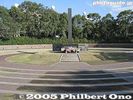
Hypocenter of atomic bombA series of concentric circles emanate from the marker.
|
|

Hypocenter markerOn August 9, 1945 an atomic bomb exploded in the sky about 500 meters above the point where this monument now stands. The area within a 2.5 kilometer radius of the hypocenter was completely devastated.
|
|

Hypocenter description
|
|

Remains of Urakami Cathedral wallNext to the hypocenter is this partial cathedral wall.
|
|
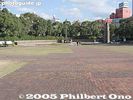
Hypocenter
|
|

Memorial at hypocenterErected in July 1995 for the 50th anniversary.
|
|

Nagasaki Atomic Bomb Museum. Next to the hypocenter is the atomic bomb museum and registry shelf which stores the names of the atomic bomb victims.
|
|

Registry Shelf storing the names of atomic bomb victims
|
|

The Registry Shelf points to the hypocenter.
|
|

Statue of Ueno Hikoma
|
|

Nagasaki Atomic Bomb Museum entrance
|
|

Statue of Ueno Hikoma
|
|

Statue description
|
|

Entrance to Hiroshima-Nagasaki photo exhibition 広島・長崎原爆写真展の入口
|
|
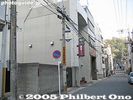
Ueno Hikoma birthplace
|
|
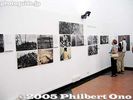
Hiroshima photos 広島原爆写真
|
|
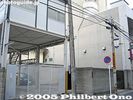
Ueno Hikoma birthplace
|
|

Hiroshima panorama photos by Shigeo HayashiThe exhibition room was divided in half by this panel. The right side was for Hiroshima, and the left side for Nagasaki.
|
|

Ueno Hikoma birthplace
|
|
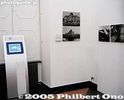
Video monitor showing Hiroshima
|
|
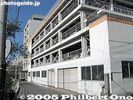
Site of Ueno Hikoma residence and studioHikoma opened Japan's first portrait studio here in 1862. The site is now occupied by a parking structure.
|
|
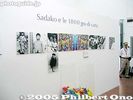
Sadako and her origami cranesBased on a story of a girl named Sadako who was exposed to the atomic bomb in Hiroshima. She was told that if she folded 1,000 paper origami cranes, she would be granted a wish. But she died at age 12 even after folding over 1,000 paper cranes.
|
|

Site of Ueno Hikoma residence and studio
|
|
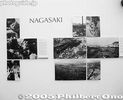
Nagasaki photos by Yosuke Yamahata 山端庸介が原爆投下翌日の写真を撮ったYosuke Yamahata was an Imperial Army photographer who was ordered to go to Nagasaki to photograph the after effects of the atomic bomb. He and two others, a writer and an artist, arrived in Nagasaki the morning after the bomb was dropped. Yamahata went on to capture over 100 extraordinary images of the devastation, people who survived, people helping the wounded, and the inevitable corpses.
山端庸介(1917−66)は陸軍報道カメラマンとして原爆投下翌日の長崎に入り,100枚以上の非常に貴重な歴史的の写真を撮った。長崎原爆資料館にも大きく展示されている。
|
|
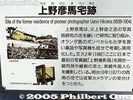
Description of Ueno Hikoma residence and studioIt says that Hikoma opened Japan's first photo studio here in 1862.
|
|
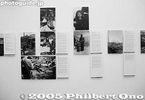
Nagasaki photos by Yosuke Yamahata. 写っている人物の当時の状況が詳しく語っています。In 1995, NHK, Japan's leadning TV station, successfully identified some of the survivors pictured in Yamahata's photographs. They even interviewed some of them who were still living. They aired a special TV program and published a book about the extraordinary stories of the survivors.
Those stories have been summarized into Italian for the photo captions in this exhibition.
写っている人物の当時の状況が詳しく語っています。10年前にNHKの取材班が山端庸介の原爆写真に写っている人物の名前とか所在を調べてまだ生きている何人かとインタービューが成功。それが、テレビ番組と本「NHKスペシャル 長崎 よみがえる原爆写真」になって大変感動しました。(テレビ番組も昨年8月に再放送された。)
そのNHK Special番組と本を参考してこの新しい写真集の写真説明文を書きました。イタリア語になっていますが、それぞれの写真を今まで外国語で詳しく説明されたことないのです。被爆者の感動的の話しをもっと海外にも伝いたいのです。
|
|
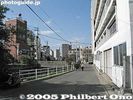
Site of Ueno Hikoma residence and studio
|
|

Nagasaki photos by Yosuke Yamahata
|
|
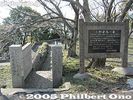
Grave of Ueno Hikoma
|
|
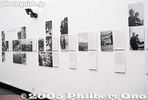
Nagasaki photos by Yosuke Yamahata
|
|
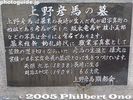
Grave of Ueno Hikoma
|
|

Nagasaki photos and origami corner 折り紙コーナーVisitors were encouraged to fold a paper crane.
|
|
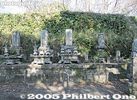
Grave of Ueno Hikoma
|
|
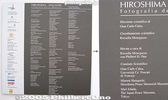
Panel for exhibition credits クレジットRossella Menegazzo and Philbert Ono were co-curators of the photo exhibition.
イタリア側でこの展覧会と図録のコーディネートをしているRossella Menegazzoさんは、ちょっと古い友人です。彼女は素晴らしい頑張りやさん。まだベネチア大学の学生のとき、夏休みに来日して僕と会いたいと言われて都内のピザ屋(彼女のバイト先)で初めて会ってあげた。
「卒業論文のため、日本人の写真家を研究したい!」と言い出してびっくりしたよ。「木村伊兵衛か土門拳、どっちがいいと思う?」と聞かれても答えないよ。(結局、土門拳になった。)しかし、参考書はほとんど日本語で英語の参考書も(僕のHP以外)非常に少ないと指摘した。でも3年後、なんとイタリア語で土門拳の論文が完成された。これは、イタリア国内で史上初の日本人写真家の論文である。ということは、彼女が日本語も勉強して読めるようになったの。凄いでしょう。
で、話しがまだ続く。彼女の草分けの論文のおかげで大学の後輩も二人、三人が日本の写真家の論文を書いたりしているの。その後輩たちにも僕ができる限り参考書など送っています。(向こうは喜ぶね。)でも、その学生さんが日本人の写真家を論文のためにインタービューしようとすると拒否されることがある(例えば奈良原 一高)。それを聞くと僕はとても恥ずかしい気持した。一方、森山大道の論文を書いた学生が本人とのインタービューが成功した。彼女がとても喜んでいたそうです。(大道さん、ありがとう。)
|
|

Nagasaki exhibition catalog: Yosuke Yamahata-Nagasaki 山端庸介の新しい写真集兼図録This book shows all of Yosuke Yamahata's photos of Nagasaki, including the the 100+ photos of Nagasaki taken on the day after the bomb was dropped. The book includes a photo which has never been published in a book. Many detailed captions about the people identified in the photos are also included. Language is Italian. Order from PhotoGuide Japan's iStore.
山端庸介(1917−66)は陸軍報道カメラマンとして原爆投下翌日の長崎に入り,100枚以上の非常に貴重な歴史的の写真を撮った。長崎原爆資料館にも大きく展示されている。
過去に山端庸介の写真集が国内外に出版されたことあるけど、撮った写真の一部しか紹介されていませんでした。今回の新しい写真集は、山端庸介の長崎関係の全集の写真集とも言えます。本に出版されたことない写真もあります。1946年に撮った写真もあります。
そしてもう一つの大きな特徴は、説明文。写っている人物の当時の状況が結構詳しく語っています。10年前にNHKの取材班が山端庸介の原爆写真に写っている人物の名前とか所在を調べてまだ生きている何人かとインタービューが成功。それが、テレビ番組と本「NHKスペシャル 長崎 よみがえる原爆写真」になって大変感動しました。(テレビ番組も昨年8月に再放送された。)
そのNHK Special番組と本を参考してこの新しい写真集の写真説明文を書きました。イタリア語になっていますが、それぞれの写真を今まで外国語で詳しく説明されたことないのです。被爆者の感動的の話しをもっと海外にも伝いたいのです。
|
|

Grave of Ueno Hikoma
|
|
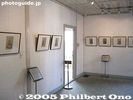
Photo museum
|
|
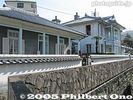
Photo museum
|
|

In Nagasaki Prefecture, Shimabara Castle is the picturesque symbol of the city. Short walk from Shimabara Station (Shimabara Railway that starts from Isahaya Station).
|
|

Besides the moat and stone walls, Shimabara Castle has two castle buildings. The tenshu main tower (rebuilt in 1964) and a corner turret (foreground).
|
|

Shimabara Castle was the government headquarters of the Shimabara Domain until 1871. Shimabara Castle's tenshu main tower and a corner turret (foreground).
|
|

Shimabara Castle is often mistaken as the site of the Shimabara Rebellion (1637-8). The rebellion actually took place at Hara Castle (now in ruins near Hara-jo Station on the Shimabara Railway) in the southern part of Shimabara Peninsula.However, the Shimabara Rebellion was sparked by the construction of Shimabara Castle when the local people were charged high taxes to finance the construction.
|
|

Shimabara Castle's castle donjon or main tower.Almost 40,000 peasants occupied Hara Castle to protest their religious and economic oppression. The rebellion lasted for about three months until the shogunate's troops overpowered and slaughtered the rebels. This effectively ended the propagation of Christianity in feudal Japan.
|
|

The castle donjon or main tower (tenshu) is a museum of Christian relics and folkcrafts. The top floor gives a fine view of the entire city and part of Mt. Fugen-dake.
|
|

Shimabara Castle and koinobori carp streamers.
|
|

After the Mt. Fugen-dake's eruption in 1991, Shimabara Castle grounds served as the command headquarters for a small contingent of Self-Defense Forces monitoring the mountain 24 hours a day.
|
|

Lookout deck on the top floor of Shimabara Castle's main tower.
|
|

View from the lookout deck on the top floor of Shimabara Castle's main tower.
|
|

View from the lookout deck on the top floor of Shimabara Castle's main tower. Looking toward Shimabara Station (end of straight road).
|
|

View from the lookout deck on the top floor of Shimabara Castle's main tower.
|
|
|

View from the turret.
|
|

After the Mt. Fugen-dake's eruption in 1991, Shimabara Castle grounds served as the command headquarters for a small contingent of Self-Defense Forces monitoring the mountain 24 hours a day.
|
|

Shimabara Castle moat.
|
|

Way to Shimabara Castle. The sign says "Beware of slippery surface of volcanic ash." 火山灰のためスリップ注意
|
|

Shimabara Station looks like a castle building. Shimabara Castle is a short walk near Shimabara Station.
|
|

Shimabara Station turnstile.
|
|

Shimabara Station train.
|
|
|
|
|














































































